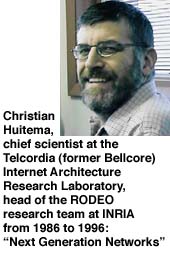 The last 15 years saw the development of the Internet, and more
generally of data services. I usually try to explain this development
by quoting two strong forces, Moore’s law and Metcalfe’s law.
As predicted by Moore’s law, the power of microprocessors has
been regularly doubling about every 18 months for the past 25
years, the trend continues, computers are becoming much more powerful
and affordable, and will pervade many more places. The networking
effect often referred to as Metcalfe's law states that the value
of a computer network grows as the square of the number of connected
elements. This law resonates with one of the principles of the
Internet, the trend to connect all computers on earth to a single
network, and may well largely explain the success of the Net.
In any case, we observe that data transmission already accounts
for more volume than voice transmission, and grows much faster.
The last 15 years saw the development of the Internet, and more
generally of data services. I usually try to explain this development
by quoting two strong forces, Moore’s law and Metcalfe’s law.
As predicted by Moore’s law, the power of microprocessors has
been regularly doubling about every 18 months for the past 25
years, the trend continues, computers are becoming much more powerful
and affordable, and will pervade many more places. The networking
effect often referred to as Metcalfe's law states that the value
of a computer network grows as the square of the number of connected
elements. This law resonates with one of the principles of the
Internet, the trend to connect all computers on earth to a single
network, and may well largely explain the success of the Net.
In any case, we observe that data transmission already accounts
for more volume than voice transmission, and grows much faster.
Today’s telecommunication network have been designed to transmit
voice, with data as an add-on service. But, at the current growth
rate, in a few years, voice will only represent a small fraction
of the global traffic. It will then not make sense to maintain
a voice network, and we will see an inversion of the current situation:
voice will run as an application within network primarily designed
for data.
Next Generation Networks represent the convergence of multiple
independent networks including voice, video and data into a single,
unified, broadband network.
The broadband network is built using optical fibers, waveband
digital multiplexing, ATM switches or IP routers. Cable modems
or digital subscriber loops can provide high speed access to home.
Voice gateways can be integrated in these modems. They provide
a classic telephony interface to the residential user, but send
the voice signals as packet over the data infrastructure. Network-based
servers, the Call Agents, manage the establishment of phone calls.
Other servers will manage the gateways to the existing phone network,
including the translation between ATM or IP call set-up and the
native signalling procedures of the phone network (SS7).Everything
is designed to be ‘transparent’, at least in the first phase:
the users will keep the same telephone handset, dial the same
numbers, benefit from the same services such as call waiting or
caller identification. There are already several such networks
being planned, or built, in the United States and in Canada.
The deployment is motivated both by short term economies and by
long term strategies. First, next generation networks can be deployed
for a fraction of the cost of classic networks built of telephony
switches and digital multiplexes. New entrants such as Level3
Communications or Qwest can thus compete without having to replicate
the huge investments of the existing carriers. But, more important,
the next generation networks are designed for the future. They
will not only enable telephony and high speed access to the Web,
e-mail and electronic commerce, but they will allow a next generation
of applications.
My team at Bellcore, now Telcordia Technologies, has been working
on the architecture of these new networks, designing for example
the ‘Media Gateway Control Protocol’ that will be used by the
Call Agents. But this is only the beginning of a new adventure.
There are many new services that the ERCIM laboratories will help
us invent!
 ERCIM News No.37 - April 1999
ERCIM News No.37 - April 1999
The last 15 years saw the development of the Internet, and more generally of data services. I usually try to explain this development by quoting two strong forces, Moore’s law and Metcalfe’s law. As predicted by Moore’s law, the power of microprocessors has been regularly doubling about every 18 months for the past 25 years, the trend continues, computers are becoming much more powerful and affordable, and will pervade many more places. The networking effect often referred to as Metcalfe's law states that the value of a computer network grows as the square of the number of connected elements. This law resonates with one of the principles of the Internet, the trend to connect all computers on earth to a single network, and may well largely explain the success of the Net. In any case, we observe that data transmission already accounts for more volume than voice transmission, and grows much faster.